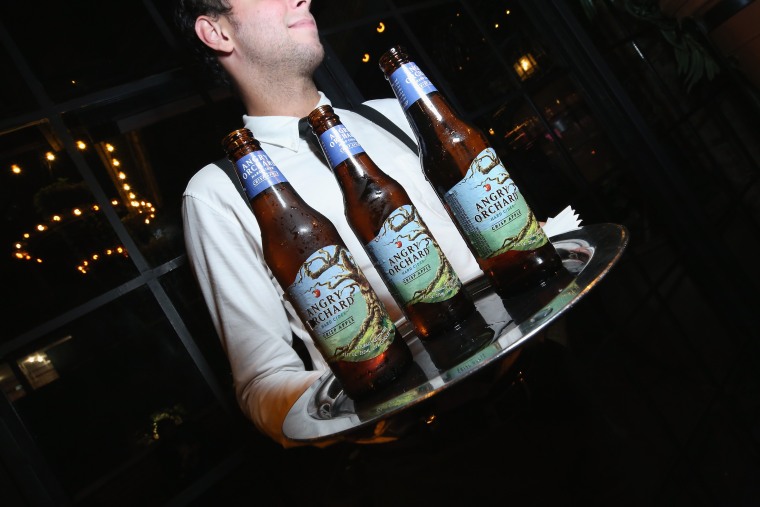As the craft beer boom matures, novelty-seeking connoisseurs are on the hunt for more esoteric libations.
Discerning drinkers and young adults put off by the bitter, hop-heavy flavor profiles popular among craft brewers today have rediscovered hard cider. And the trend bears all the trappings of the microbrewery culture: A focus on local ingredients, small-batch production and, in a growing number of American cities, bars where cider — not beer — is the star of the show.
“I think it’s just great for the category, and opens up people’s eyes to what cider is,” said Aaron Zacharias, managing partner of the Northman Cider Bar, which opened in Chicago last month. Zacharias said the Northman has 19 draft lines and a firkin (a kind of keg) dedicated to cider, plus 80 ciders available by the bottle or can.
Read More: Craft Beer Fans May Face Squeeze With Hops in Short Supply
Thirsty patrons can now find craft cider bars in New York City; San Francisco; Seattle; Chicago; Rochester, N.Y.; Cleveland, and Portland, Ore. Milwaukee and Toronto are on tap to get their own cider bars this spring.
“I think it’s an underserved market, and we can tell by the amount of customers coming in,” said Patrick Jaouen, co-owner of Mullers Cider House in Rochester, N.Y., which opened in January.
“What you’ve seen across beer is happening in cider, but at a much accelerated pace,” said Caroline Levy, an analyst at CLSA. Although cider has long been popular in the U.K., only recently has it made inroads in the American market, due largely to the success of Boston Beer Co.’s Angry Orchard brand.
(Another attribute boosting the popularity of hard cider is that, unlike beer, it’s gluten-free — a priority for many Americans today.)
Although Samuel Adams parent Boston Beer Co. is, legally speaking, a craft beer company since it produces fewer than the cutoff of 6 million barrels a year, it’s the Anheuser-Busch of the cider world, with its Angry Orchard brand claiming a dominant share of the hard cider market. Its success has prompted big beer conglomerates to pile on: In 2014, both Anheuser-Busch InBev and MillerCoors debuted cider brands (Johnny Appleseed and Smith & Forge, respectively).
Read More: Birra Nursia Brewed by American Monks in Italy Hits U.S. Shelves
Craft cider bar owners have a complicated relationship with Big Cider. While they might dismiss mainstream brands as too sweet or lacking in complexity, they admit that the marketing and distribution resources poured into the cider category by larger players have benefitted them.
“You’ll see now that some of those bigger cider houses are at some of the larger music festivals,” Zacharias said. “Even though it’s not some of the ciders we serve here, it gets people interested, it gets people intrigued.”
“We were pretty busy right out of the gate and have definitely seen a steady growth as well,” said Julie Tall, who opened Seattle’s Capitol Cider in 2013. In general, her customers today know more about hard cider than they did when she opened three years ago. “Sure, you’ll get people trying it for the first time, but we also get a much more sophisticated cider drinker,” she said.
In relative terms, the cider category is still tiny — around $436 million, according to market research firm IRI. That’s a drop in the keg compared to the $105.9 billion Americans spent on beer last year, or even the $22.3 billion of that total spent on craft beer.
But the rise of the cider category has been meteoric, with an annualized growth rate of just over 27 percent for the past five years, according to market research firm IBISWorld.
Paradoxically, perhaps the best argument that craft cider is hitting its stride is that bigger cider brands are flagging. IBISWorld predicts that the category will slow down to an annualized growth rate of just over 1 percent through 2020.
Experts have suggested that the debut of alcoholic hard sodas is one factor siphoning away young adults with a taste for sweet beverages, but there also is a sense that drinkers to whom cider appeals are switching to smaller competitors.
“During the fourth quarter, we saw the cider category start to decline, even as new cideries continued to enter,” Boston Beer Co. president and CEO Martin Roper told investors in February. “I certainly think that we're probably losing some casual cider drinkers, who tried it and maybe are moving on or are exploring other craft sort of opportunities or hard cider opportunities,” he said.
Read More: McDonald's Starts Selling Beer in World's Most 'Spirited' Nation
“What we’re seeing more is just this explosion of more craft focused cider brands so I think there will be some opportunity for growth there,” said Beth Bloom, food and drink analyst at the NPD Group, a market research firm. “I would say some of these newer brands coming to market are chipping away at the share of those bigger brands.”
This scenario, built on the history of the craft beer category’s success, makes bar owners like Jaouen optimistic.
“Cider has its own culture in and of itself. I see it growing alongside it but as its own separate entity,” he said. “You’d be surprised at just the range of what’s out there.”
